The Bulk Carriers
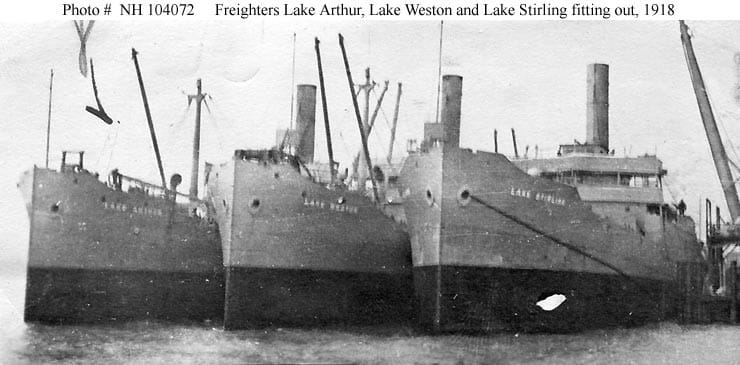
Definition
Bulk carriers, also called “bulkers” in their “modern” definition could be quite ancient, applied to all ships and boats that carried unpackaged cargo. This is still the definition today, and bulk carriers makes 15% to 20% of the modern carrier fleets. The modern definition is related to their particular cargo, generally unique and free-flowing, but dry contrary to liquid carriers (tankers are the most famous). Until the arrival of the first Container ships in the 1950s, cargo were diversely packed and carried inside wide holds that could receive pretty much any load, but free-flowing ones. The main cargo shifting problem obliged to compensate for the internal mass displacements in case of excessive roll. So bulkhead and ballasts systems were devised to compensate. Bulk cargo could also threatens a ship through spontaneous combustion, and cargo saturation.
Traditional bulk transport
Bulk was transported the slow way, inside sacks stacked onto pallets, deposited by a crane. The pallets and nets ensured a stability of the load, but the time required for that procedure and materials needed were clearly a problem. In alternative plywood bins purpose-built were installed into the hold, while the cargo was guided through small hatches by wooden feeders and shifting boards. But this was also labor-intensive and costly.
After specialized bulk carriers, the first self-unloader was the lake freighter Hennepin in 1902 on the Great Lakes. Lakers long has been special vessels and bulk carriers became almost the norm, notably to carry grain from the great plains or metal ore from the northern mines to the steel mills. They used conveyor belt to move the cargo. The double bottom was adopted in 1890, the triangular structure of the ballast tanks in 1905, and diesel appeared from 1911.
Origins: SS John Bowes
The first recorded, purpose-build bulk carrier was the SS John Bowes (1852). Built by Palmer Brothers & Co, Jarrow for Charles Mark Palmer, in Newcastle, this was a mixed ship but steamer-first (three masts), which made its maiden voyage in 27 July 1852, and was foundered off Ribadesella (Spain) in 12 October 1933, after being completely refitted in 1864 and 1883.
This forerunner in many ways was the first:
-Fully constructed of steel, its rigidity seemed to ensure a long life.
-Steamer (although it could be rigged in schooner), it ensured a good regularity of service.
-More importantly displayed additional ballasted holds for seawater, making operation quick and safe.
The latter were longitudinal iron tanks beneath each hold, added in 1853 after tried many solution. In her long active life, the Bowes transported coal, and other goods under Scandinavian flag (Spec, Transit) and Spanish (Carolina, Valentin Fierro, Villa Selgas).
This bulk carrier originally chartered by the General Iron Screw Collier Company, saved time and was very profitable for his owner. She was quickly imitated and became a standard.
SS John Bowes Specs:
Dimensions : 30,8 m x 5,28 m x 3,20 m
propulsion : 2 steam Reciprocating TE 2,35 hp, one screw, 9 knots, new engines in 1864 and 1883.
Capacity: Carried 650 tonnes of coal with a loading/unloading speed superior to two sail coalers of the time.
The last tall ships were often bulkers
fall 1800s/early 1900s tall ships built in metal, with hydraulic winches and steam-operated rigging, were often bulk carriers by default. The numerous masts were a liability to load and unload cargo, and the load itself was not profitable enough to use a voracious steam engine with its large coal supply. So the most glorious and noblest ships to ever roam the seas were used to carry dirty charcoal or guano, the lowest, cheapest crap around. So were the last tall ships, like the legendary 3-masted barque of the Pamir class (1905), five masted barques France II (1911) and R. C. Rickmers (1907) or the fantastic Thomas L. Lawson, the only seven-masted schooner ever.
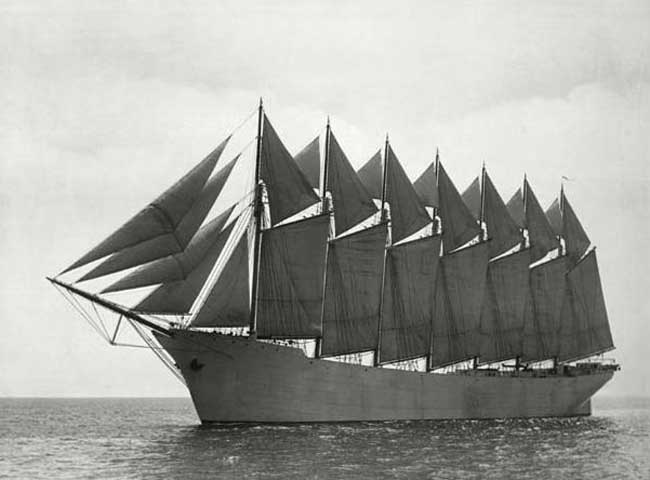
What if the Thomas Lawson has been preserved, would it be profitable now ? Is it the way forward ?
ww1 and the interwar
Until 1914, this type of steam-only ballasted ship was predominant, faced with a traffic still largely populated by tall ships in iron. In 1905 alone, about fifty of these steel vessels were launched. The sail seemed still profitable for many shipowners, used on certain segments of shipping (to spare coal). Progress would be slow with new devices to open and close the holds, new hoists to ease maneuvers, new ballasting systems.
In 1914-18, maritime traffic, British in majority, was the victim the U-Boat total war launched by the German Empire from 1917. The number of sunken sailboats increased sharply, particularly because of their slow speed and inability to evade U-boats. Steamers as well as tall ships paid their share. In 1917, the admiralty faced so much losses it was decided to launch a massive shipbuilding plan for standardized freighters. These standards ships (type A to J) defined by the Emergency Fleet Corporation (EFC) still constituted about half of the shipping in 1939. Most were “regular”, universal carriers able to carry any packed cargo as well as bulk in their large holds, thanks to their ballasts. But they were also specialized bulk carriers, generally of smaller size.

A “C” type cargo in 1918
Bulk carriers in ww2
Indeed before the war, the need to transport about 25 million tons for metal ores was filled by generally coasters of relatively small size with the exception of the “lakers”. The battle of the Atlantic cost for shipping was also considerable, for the British fleet in particular until the US entered the fray. Losses reached an all-out peak in late 1942, before convoys systems improved, new specialized ships arrived en masse, and crucially new standard carriers were built, notably the famous Liberty-ships. But not too many bulk carriers were built. This was compounded by the conversion of many Merchant aircraft carriers (MAC), which retained their cargo (at least partially) while offering self-defence capabilities.

Model kit rendition of a wartime MAC ships of the Empire Mac Alpine type – Royal Museum Greenwich. These ships will be treated in a post later.
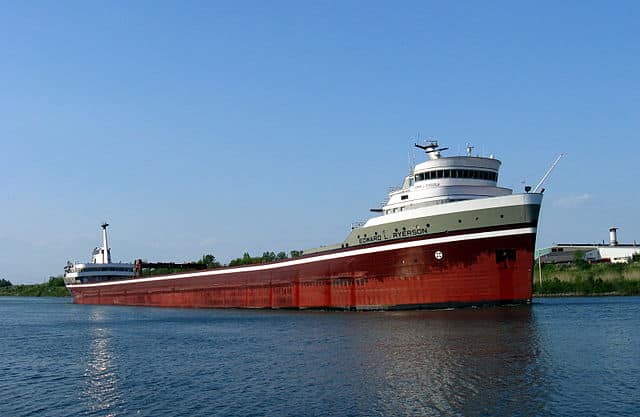
“Laker” Edward L Ryerson, a bulk carrier tailored for the American great lakes, very distinctive with their “two island” configuration far apart fore and aft and the cargo in between.
Bulk carriers postwar
In 1950, the first container ship, Ideal X, revolutionized cargo transport forever. Despite of this, old style cargo carriers served for many more years (until the late 1980s) and the bulk carriers persisted, helped in particular by new self-loading systems, ballast systems, and larger construction. In fact the last ones almost reached supertanker standards like the Berge Stahl.
Berge Stahl (1986)
This bulk carrier is a monster. With its appearance of supertanker, it seems promised to transport heavy liquid bulk and was actually built in South Korea (Hyundai) in order to transport iron ore. Launched in 1986 on behalf of Norwegian shipowner Bergesen Worldwide Gas ASA, it could only unload at Europoort, Rotterdam in Holland and the Marítimo Terminal in Ponta da Madeira in Itaqui, Brazil.
It currently retains the record for a coal carrier, and that for a bulk carrier. The only larger “cargo ship” is currently the container ship Emma Maersk. Yet, like its ancestor of 1850, this giant has all its length reserved for the payload, its castle and crew, propulsion being at the extreme rear, and being ensured by a single propeller of 9 meters in diameter. Like the John Bowes, her return crossings are empty on ballasts filled with seawater. Their desalinate process and holds cleaning is part of such ship’s daily life at anchor.
Technical specifications of the Berge Stahl:
Dimensions: 342.1 meters by 63.5 m by 23 m of draft.
Propulsion: 1 Hyundai Diesel of 27610 cv for a single propeller, 13,5 knots.
Capacity: A load of 364 768 tons of iron ore.
MS Ore Brazil (2011)
First called Vale Brasil she is own by Vale Shipping Holding Pte. Ltd, Singapore. Built by Daewoo she is a true monster, larger than the Berge Stahl and Bold Challenger at 198,980 GT, 67,993 NT, 402,347 DWT, 362 m oa (1200 fts), by 65.0 m (213.3 ft) and 23.0 m (75.5 ft) (moulded) draught. She has a fiex ptched propeller, moved by a by MAN B&W 7S80ME-C8 (29,260 kW) and three uxiliary engines Hyundai-HiMSEN 6H21/32 (3 × 1,270 kW). Top speed is 15.4 knots (28.5 km/h; 17.7 mph) and crew 33. There was a controversy about this new class of ship called “Valemax” size, ordered by Vale with a deadweight tonnage of just over 400,000 tonnes, too much for most Chinese harbours. In consequence this was slimmed down to 380,000 tonnes, but only on paper. As a result they are not loaded to full capacity.
Modern bulk Carriers
Standards (recent classifications):
-Handysize: 10,000-35,000 tons
-Handymax: 35,000-50,000 tons
-Panamax: 50 000-80 000 tonnes
-Capesize/overpanamax: 80,000-300,000 tons.
Most large bulk carriers have 5 to 9 holds and are equipped with cranes between each hold, this for the less equipped ports. Some are called “self-discharging” and have a lateral strip loading system (“grasshopper”). Others are said to be “gearless”, devoid of any unloading equipment and entirely depends on well-equipped harbors. These are the most economical. There are also relatively complex OBOs (Ore Bulk carriers), BIBOs which are responsible for packing the bulk during the voyage, and finally types of specific bulk carriers such as those of the great American lakes and the “barges” Bulk carriers “. So this type would probably live on for decades, as long as containers are not used to carry bulk (which is a real possibility) so to standardized even more shipping.
Links and source
http://maritime-connector.com/bulk-carrier/
http://www.shipscribe.com/shiprefs/efc/index.html
Video: Largest great lakes bulk carrier https://www.youtube.com/watch?v=2cmGK94imug
U.S. Shipping and Shipbuilding: Trends and Policy Choices
shippipedia.com/ships/ship-types/bulker/
http://www.shipscribe.com/mckellar/pix/1014.html
http://www.shipscribe.com/shiprefs/efc/Designs.html
https://en.wikipedia.org/wiki/Hog_Islander


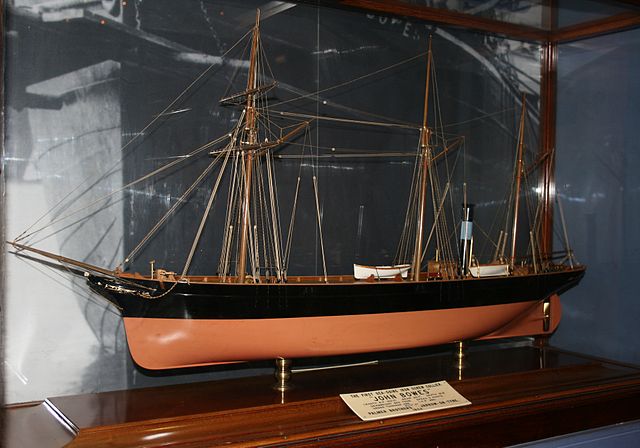

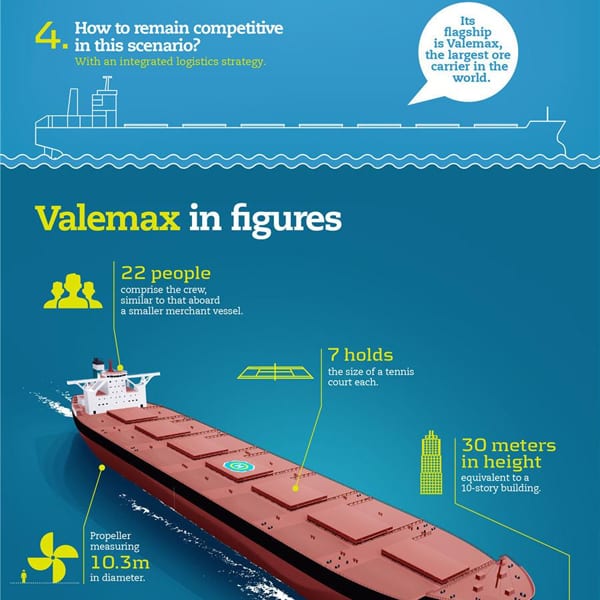
 Latest Facebook Entry -
Latest Facebook Entry -  X(Tweeter) Naval Encyclopedia's deck archive
X(Tweeter) Naval Encyclopedia's deck archive Instagram (@navalencyc)
Instagram (@navalencyc)





 French Navy
French Navy Royal Navy
Royal Navy Russian Navy
Russian Navy Armada Espanola
Armada Espanola Austrian Navy
Austrian Navy K.u.K. Kriegsmarine
K.u.K. Kriegsmarine Dansk Marine
Dansk Marine Nautiko Hellenon
Nautiko Hellenon Koninklije Marine 1870
Koninklije Marine 1870 Marinha do Brasil
Marinha do Brasil Osmanlı Donanması
Osmanlı Donanması Marina Do Peru
Marina Do Peru Marinha do Portugal
Marinha do Portugal Regia Marina 1870
Regia Marina 1870 Nihhon Kaigun 1870
Nihhon Kaigun 1870 Preußische Marine 1870
Preußische Marine 1870 Russkiy Flot 1870
Russkiy Flot 1870 Svenska marinen
Svenska marinen Søværnet
Søværnet Union Navy
Union Navy Confederate Navy
Confederate Navy Armada de Argentina
Armada de Argentina Imperial Chinese Navy
Imperial Chinese Navy Marinha do Portugal
Marinha do Portugal Mexico
Mexico Kaiserliche Marine
Kaiserliche Marine 1898 US Navy
1898 US Navy Sovietskiy Flot
Sovietskiy Flot Royal Canadian Navy
Royal Canadian Navy Royal Australian Navy
Royal Australian Navy RNZN Fleet
RNZN Fleet Chinese Navy 1937
Chinese Navy 1937 Kriegsmarine
Kriegsmarine Chilean Navy
Chilean Navy Danish Navy
Danish Navy Finnish Navy
Finnish Navy Hellenic Navy
Hellenic Navy Polish Navy
Polish Navy Romanian Navy
Romanian Navy Turkish Navy
Turkish Navy Royal Yugoslav Navy
Royal Yugoslav Navy Royal Thai Navy
Royal Thai Navy Minor Navies
Minor Navies Albania
Albania Austria
Austria Belgium
Belgium Columbia
Columbia Costa Rica
Costa Rica Cuba
Cuba Czechoslovakia
Czechoslovakia Dominican Republic
Dominican Republic Haiti
Haiti Hungary
Hungary Honduras
Honduras Estonia
Estonia Iceland
Iceland Eire
Eire Equador
Equador Iran
Iran Iraq
Iraq Latvia
Latvia Liberia
Liberia Lithuania
Lithuania Mandchukuo
Mandchukuo Morocco
Morocco Nicaragua
Nicaragua Persia
Persia San Salvador
San Salvador Sarawak
Sarawak Uruguay
Uruguay Venezuela
Venezuela Zanzibar
Zanzibar Warsaw Pact Navies
Warsaw Pact Navies Bulgaria
Bulgaria Hungary
Hungary

 Bundesmarine
Bundesmarine Dutch Navy
Dutch Navy Hellenic Navy
Hellenic Navy Marina Militare
Marina Militare Yugoslav Navy
Yugoslav Navy Chinese Navy
Chinese Navy Indian Navy
Indian Navy Indonesian Navy
Indonesian Navy JMSDF
JMSDF North Korean Navy
North Korean Navy Pakistani Navy
Pakistani Navy Philippines Navy
Philippines Navy ROKN
ROKN Rep. of Singapore Navy
Rep. of Singapore Navy Taiwanese Navy
Taiwanese Navy IDF Navy
IDF Navy Saudi Navy
Saudi Navy Royal New Zealand Navy
Royal New Zealand Navy Egyptian Navy
Egyptian Navy South African Navy
South African Navy






























 Ukrainian Navy
Ukrainian Navy dbodesign
dbodesign